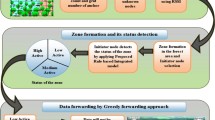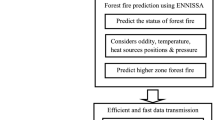Abstract
Early detection of a forest fire can save our flora and fauna. Ad Hoc Wireless Sensor Networks (WSN) plays an important role in detecting forest fire. This article proposes a model for early detection of forest fire through predictive analytics. In this approach, the forest area is divided into different zones. Status of a zone, i.e., High Active (HA), Medium Active (MA), and Low Active (LA), is predicted by applying the semi-supervised classification technique. Each zone has static sensors, mobile sensors, and an Initiator node. Initiator nodes of LA and MA zone transfer their mobile nodes (MN) to the nearer HA zone for the quick prediction of forest fire by using the Random trajectory generation (RTG) technique. This technique generates the intermediate points between LA/MA to HA zone to create the movement path of MN. Compressed sensing based Gradient descent (GD) localization technique is used to track the movement of MN by the anchor nodes. This technique reduces the energy consumption of MN that causes an increase in network lifetime. The analysis of the localization error of MN during its traveling towards the HA zone increases the accuracy of its path detection. Thus the increase of sensor nodes in the HA zone results in transferring a huge amount of data from HA zone to base station for quick prediction of a forest fire.























Similar content being viewed by others
Explore related subjects
Discover the latest articles, news and stories from top researchers in related subjects.References
Abdalhaq B, Cortés A, Margalef T, Luque E (2005) Enhancing wildland fire prediction on cluster systems applying evolutionary optimization techniques. Future Gener Comput Syst 21:61–67. https://doi.org/10.1016/j.future.2004.09.013
Abo-Zahhad M, Farrag M, Ali A (2016) Modeling and minimization of energy consumption in wireless sensor networks. In: Proceedings of the IEEE International Conference on Electronics, Circuits, and Systems
Ahmadi H, Viani F, Bouallegue R (2018) An accurate prediction method for moving target localization and tracking in wireless sensor networks. Ad Hoc Netw 70:14–22. https://doi.org/10.1016/j.adhoc.2017.11.008
Alwan NAS, Hussain ZM (2018) Compressive sensing for localisation in wireless sensor networks: an approach for energy and error control. IET Wireless Sens Syst. https://doi.org/10.1049/iet-wss.2016.0112
Alwan NAS, Hussain ZM (2019) Compressive sensing with chaotic sequences: an application to localization in wireless sensor networks. Wireless Personal Commun 105(3):941–950
Alwan NAS, Mahmood AS (2015) Distributed gradient descent localization in wireless sensor networks. Arab J Sci Eng 40:893–899
Bilodeau JS, Bouzouane A, Bouchard B, Gaboury S (2018) An experimental comparative study of RSSI-based positioning algorithms for passive RFID localization in smart environments. J Ambient Intell Human Comput 9:1327–1343. https://doi.org/10.1007/s12652-017-0531-3
Chen W, Wassell IJ (2012) Energy-efficient signal acquisition in wireless sensor networks: a compressive sensing framework. IET Wireless Sensor Systems 2:1. https://doi.org/10.1049/iet-wss.2011.0009
Cortez P, Morais A (2007) A Data mining approach to predict forest fires using meteorological data. In: Proceedings of the 13th Portuguese Conference on Artificial Intelligence
Díaz-Ramírez A, Tafoya LA, Atempa JA, Mejía-Alvarez P (2012) Wireless sensor networks and fusion information methods for forest fire detection. Proced Technol 3:69–79
Dziengel N, Seiffert M, Ziegert M et al (2016) Deployment and evaluation of a fully applicable distributed event detection system in Wireless Sensor Networks. Ad Hoc Netw 37:160–182. https://doi.org/10.1016/j.adhoc.2015.08.017
Erdemir E, Tuncer TE (2018) Path planning for mobile-anchor based wireless sensor network localization: static and dynamic schemes. Ad Hoc Netw 77:1–10. https://doi.org/10.1016/j.adhoc.2018.04.005
Gui L, Yang M, Fang P, Yang S (2017) RSS-based indoor localisation using MDCF. IET Wireless Sensor Systems. https://doi.org/10.1049/iet-wss.2016.0085
Hamie J, Denis B, D’Errico R, Richard C (2015) On-body toa-based ranging error model for motion capture applications within wearable UWB networks. J Ambient Intell Human Comput 6:603–612
Hu K, Chen Y, He S, et al (2019) ILoc: a low-cost low-power outdoor localization system for internet of things. 2019 IEEE Global Communications Conference, GLOBECOM 2019—Proceedings pp 1–6. https://doi.org/10.1109/globecom38437.2019.9013972
Javadi SH, Mohammadi A (2017) Fire detection by fusing correlated measurements. J Ambient Intell Human Comput 10:1–9. https://doi.org/10.1007/s12652-017-0584-3
Jiang R, Zhu Y, Liu T, Chen Q (2017) Compressive detection and localization of multiple heterogeneous events in sensor networks. Ad Hoc Netw 65:65–77. https://doi.org/10.1016/j.adhoc.2017.08.001
Kansal A, Singh Y, Kumar N, Mohindru V (2016) Detection of forest fires using machine learning technique: a perspective. Proceedings of 2015 3rd International Conference on Image Information Processing, ICIIP 2015:241–245. https://doi.org/10.1109/iciip.2015.7414773
Kaur H, Sood SK (2019a) Adaptive neuro fuzzy inference system (ANFIS) based wildfire risk assessment. J Exp Theor Artif Intell 00:1–21. https://doi.org/10.1080/0952813x.2019.1591523
Kaur H, Sood SK (2019b) Fog-assisted IoT-enabled scalable network infrastructure for wildfire surveillance. J Netw Comput Appl 144:171–183. https://doi.org/10.1016/j.jnca.2019.07.005
Khetwal MN, Ishrat M (2012) A study of forest-fire surveillance system based on MANET for Uttarakhand Hills. Pragyan 10:36–39
Kim Y, Jung W, Bang H (2019) Real-time path planning to dispatch a mobile sensor into an operational area. Information Fusion. https://doi.org/10.1016/j.inffus.2018.01.010
Lou Y, Osher S, Xin J (2015) Computational Aspects of Constrained L1-L2 Minimization for Compressive Sensing. In: Le Thi HA, Pham Dinh T, Nguyen NT (eds) Modelling, computation and optimization in information systems and management sciences. Springer, Cham, pp 169–180
Lv C, Wang J, Zhang F (2018) Forest fire spread model based on the grey system theory. J Supercomput 76:3602–3614
Mahmoud MAI, Ren H (2018) Forest fire detection using a rule-based image processing algorithm and temporal variation. Math Probl Eng. https://doi.org/10.1155/2018/7612487
Misra S, Singh S, Khatua M, Obaidat MS (2015) Extracting mobility pattern from target trajectory in wireless sensor networks. Int J Commun Syst 28:213–230. https://doi.org/10.1002/dac.2649
Moussa N, El Belrhiti El Alaoui A, Chaudet C (2018) A novel approach of WSN routing protocols comparison for forest fire detection. Wireless Netw. https://doi.org/10.1007/s11276-018-1872-3
Nguyen MT, Teague KA (2017) Compressive sensing based random walk routing in wireless sensor networks. Ad Hoc Netw 54:99–110. https://doi.org/10.1016/j.adhoc.2016.10.009
Novakovic J, Veljovi A, Iiic S et al (2017) Evaluation of classification models in machine learning. Theory Appl Math Comput Sci 7:39–46
Philomina S (2013) Ad-Hoc network and microcontroller remote for early warning system in forest fire control. Int J Adv Res Electr Electron Instrument Eng 2:2127–2132
Qi Y, Cheng P, Bai J et al (2016) Energy-efficient target tracking by mobile sensors with limited sensing range. IEEE Trans Industr Electron 63:6949–6961. https://doi.org/10.1109/tie.2016.2584000
Saukh O, Hasenfratz D, Thiele L (2014) Route selection for mobile sensor nodes on public transport networks. J Ambient Intell Human Comput. https://doi.org/10.1007/s12652-012-0170-7
Sharma H, Haque A, Jaffery ZA (2019) Maximization of wireless sensor network lifetime using solar energy harvesting for smart agriculture monitoring. Ad Hoc Netw 94:101966. https://doi.org/10.1016/j.adhoc.2019.101966
Sheltami TR, Khan S, Shakshuki EM, Menshawi MK (2016) Continuous objects detection and tracking in wireless sensor networks. J Ambient Intell Human Comput 7:489–508. https://doi.org/10.1007/s12652-016-0380-5
Shu Y, Cheng P, Gu Y et al (2015) TOC: localizing wireless rechargeable sensors with time of charge. ACM transactions on sensor networks (TOSN) 11:1–22. https://doi.org/10.1145/2700257
Singh PK, Sharma A (2017) An insight to forest fire detection techniques using wireless sensor networks. In: 4th IEEE International Conference on Signal Processing, Computing and Control, ISPCC 2017
Sinha D, Kumari R, Tripathi S (2019) Semisupervised Classification Based Clustering Approach in WSN for Forest Fire Detection. Wireless Pers Commun. https://doi.org/10.1007/s11277-019-06697-0
Technitis G, Othman W, Safi K, Weibel R (2015) From A to B, randomly: a point-to-point random trajectory generator for animal movement. Int J Geogr Inform Sci. https://doi.org/10.1080/13658816.2014.999682
Vikram R, Kumari R, Ghosh R, Sinha D (2018) Localization of sensors in WSN during emergencies services (LSWES). In: Proceedings of the IEEE Conference on Information and Communication Technology (CICT), 2018 Record no. 45507
Wei Y, Li W, Chen T (2016) Node localization algorithm for wireless sensor networks using compressive sensing theory. Pers Ubiquit Comput. https://doi.org/10.1007/s00779-016-0951-7
Wu CM, Chang RS, Lee PI, Yen JH (2013) An innovative scheme for increasing connectivity and life of ZigBee networks. J Supercomput 65:136–153. https://doi.org/10.1007/s11227-011-0696-z
Wu Q, Cao J, Zhou C et al (2018) Intelligent Smoke Alarm System with Wireless Sensor Network Using ZigBee. Wireless Communications and Mobile Computing. https://doi.org/10.1155/2018/8235127
Jilbab A, Bourouhou A (2017) Hybridized model for early detection and smart monitoring of forest fire. Transac Mach Learn Artif Intell. https://doi.org/10.14738/tmlai.54.3206
Yaakob N, Khalil I, Kumarage H et al (2015) By-passing infected areas in wireless sensor networks using BPR. IEEE Trans Comput 64:1594–1606. https://doi.org/10.1109/tc.2014.2345400
Yang J, Liu F, Cao J (2017) Greedy discrete particle swarm optimization based routing protocol for cluster-based wireless sensor networks. J Ambient Intell Human Comput. https://doi.org/10.1007/s12652-017-0515-3
Yoshimura Y, Sinatra R, Krebs A, Ratti C (2018) Analysis of visitors’ mobility patterns through random walk in the Louvre museum. Journal of Ambient Intelligence and Humanized Computing. https://doi.org/10.1007/s12652-019-01428-6
Zhang P, Wang S, Guo K, Wang J (2018) A secure data collection scheme based on compressive sensing in wireless sensor networks. Ad Hoc Netw 70:73–84. https://doi.org/10.1016/j.adhoc.2017.11.011
Acknowledgements
This research is funded in parts by DST/SERB project ECR/2017/000983 grants. The authors would like to thanks the DST/SERB India.
Author information
Authors and Affiliations
Corresponding author
Additional information
Publisher's Note
Springer Nature remains neutral with regard to jurisdictional claims in published maps and institutional affiliations.
Rights and permissions
About this article
Cite this article
Vikram, R., Sinha, D., De, D. et al. PAFF: predictive analytics on forest fire using compressed sensing based localized Ad Hoc wireless sensor networks. J Ambient Intell Human Comput 12, 1647–1665 (2021). https://doi.org/10.1007/s12652-020-02238-x
Received:
Accepted:
Published:
Issue Date:
DOI: https://doi.org/10.1007/s12652-020-02238-x




